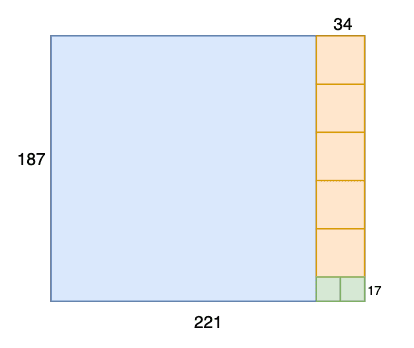date: 2025-03-06
title: AAM-HW-2
status: DONE
author:
- AllenYGY
tags:
- NOTE
- Assignment
- AAM
publish: trueAAM-HW-2
Problem 1.
The aspect ratio of a rectangular image or screen is the ratio of its width to its height. It is usually expressed as
-
Calculate the aspect ratio of your phone or computer, simplify so that
x : yare integers in lowest terms,
i.e.gcd(x, y) = 1.-
What is the aspect ratio of TV series, anime, or video channels (Bilibili, YouTube...) that you are currently watching?
Phone/computer aspect ratio: Example - -
Name one TV series and one anime with a
4:3aspect ratio, together with its release date.
TV series with 4:3 aspect ratio: Friends (Released: September 22, 1994).
Anime with 4:3 aspect ratio: Naruto (Season 1) (Released: October 3, 2002).
-
-
What is the aspect ratio of a rectangle that when folded in half lengthwise yields a smaller rectangle with the same aspect ratio?
- Where does this aspect ratio appear in everyday life?
1). The aspect ratio is
2). Seen in paper folding, as A-series papers retain shape when halved.
- Where does this aspect ratio appear in everyday life?
Problem 2. Homogeneous Linear Recurrence with constant coefficients
A sequence of numbers defined by specifying the values of
i. Write down an equation for
i. Equation for
Given the recurrence relation:
Dividing through by
Rearranging:
This is a quadratic equation:
Thus, the two solutions for
ii. In the case of Fibonacci numbers
ii. Fibonacci numbers
For Fibonacci numbers:
Solving using the quadratic formula:
Thus, the two solutions are:
iii. It is not true that
Knowing that
Solution to part iii:
The guess is that:
We are tasked with finding
Step 1: Use the first condition
Substituting
Since
From
Step 2: Use the second condition
Substituting
Since
Factor
From
Step 3: Compute
Recall that
Simplify:
Thus:
Solve for
From
Final Answer:
Problem 3. Combinatorics. Solve one of the following two questions.
Choose the first question
i. Mr. Chou is a nunchucks ("dual-section stick") master. He shouts either in "Heng!" (1 beat) or "Ha-Hi!" (2 beats).
For example, for 4 beats, he can shout "Heng Heng Ha-Hi!".
- In how many possible ways can Mr. Chou shout for a combo move with 13 beats?
Ancient Indian poet and mathematician Pingala (around 200 BC) studied questions of this type, in the context of Sanskrit poetry.
To solve how many ways Mr. Chou can shout for 13 beats:
- Each beat combo can consist of:
- "Heng!" (1 beat),
- "Ha-Hi!" (2 beats).
The problem reduces to a Fibonacci sequence:
Compute up to
Final Answer:
Problem 4: Prime Factorization and Euler's Totient Function
-
What is the prime factorization of 60?
Prime factorization:
-
List all numbers between 1 and 60 which are coprime to 60. What is Euler's totient
-
A number is coprime to 60 if it shares no common prime factors with
That means numbers that are not divisible by the prime factors -
The numbers coprime to 60 are:
-
Euler's totient function for
-
-
For two of the numbers
Let's find the modular inverses for two numbers:-
Consider
Using the extended Euclidean algorithm, we find
-
Consider
Using the extended Euclidean algorithm, we find
-
Problem 5.
i. Use the Euclidean Algorithm to show that 314 and 159 are coprime.
- Apply the Euclidean algorithm to
ii. Use the Euclidean Algorithm to find
-
Apply the Euclidean algorithm to
-
Decompose a

- Express
- Write down its convergents.
The convergents are:- First:
- Second:
- Third:
- First:
iii. Use the extended Euclidean algorithm to find
Compute
The last non-zero remainder is:
Work Backwards to Find the Linear Combination
We now express
-
Start with the second-to-last equation:
-
Substitute
-
Substitute
-
Substitute
-
Substitute
The
General solution:
The general solution to
Problem 6.
1. Solve the Chinese Remainder Theorem problem step by step:
Solve the system of congruences:
Step 1. Compute the product of the moduli.
Step 2. Compute individual terms
Let
-
For
Using the extended Euclidean Algorithm:
-
For
Using the extended Euclidean Algorithm:
-
For
Using the extended Euclidean Algorithm:
Step 3. Construct the solution using the Chinese Remainder Theorem formula.
The solution is:
Add them together:
Simplify modulo
Thus, the solution is:
2. Adapt the previous question into a word problem for a general audience:
A wizard is trying to hide a magical scroll. The scroll is located such that:
- When it is divided into groups of 7, there are 4 remaining scrolls.
- When it is divided into groups of 8, there are 3 remaining scrolls.
- When it is divided into groups of 9, there are 2 remaining scrolls.
Where is the scroll located? To calculate this, use the magic formula:
Replace